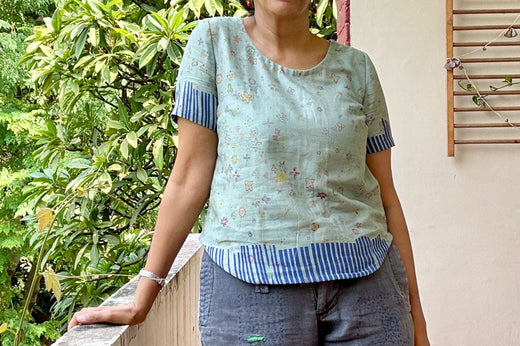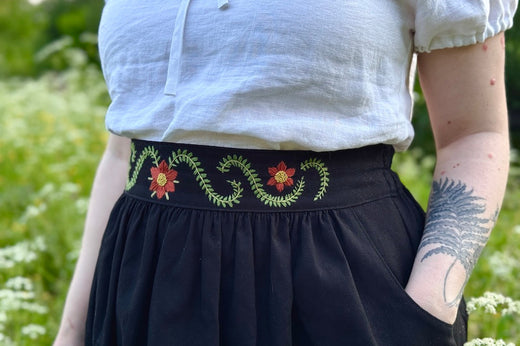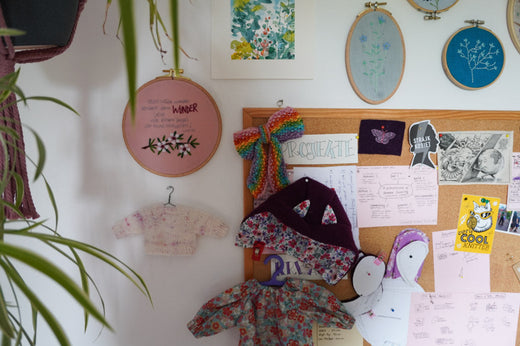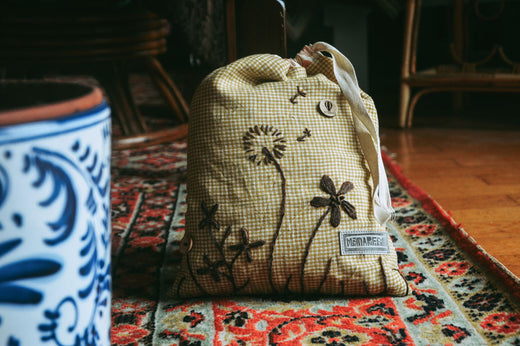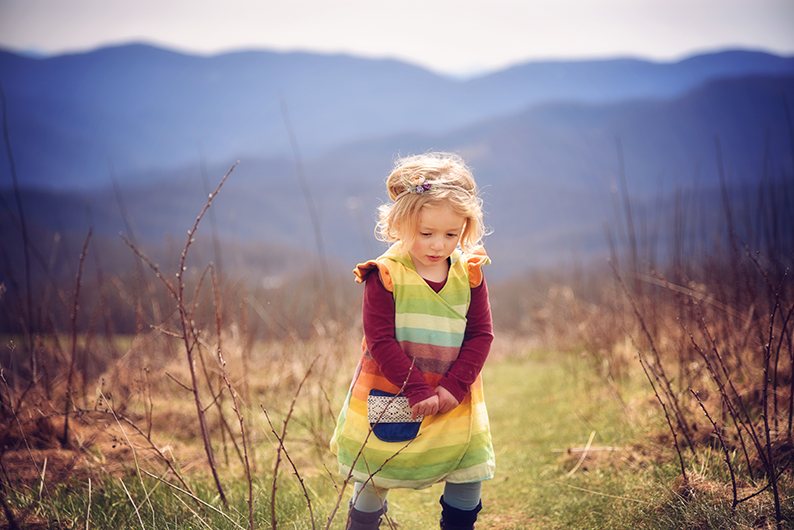We're so pleased to welcome Storyteller Sashanna Hart to the Twig + Tale blog. Faced with unexpected health issues, Sashanna was inspired to consider what sustainability means to her. Here, she examines the resources - both tangible and intangible - that are important to her in creating a sustainable sewing practice, and shares some of her beautiful photography.

On February 19 I landed in France with my husband, Kevin, and son, Jack, with five heavy bags, prepared for three months of exploring a beautiful medieval walled town in Burgundy, called Beaune. Among those bags were scattered the necessities for sewing away from home. On the morning of the 22nd, I received the news that I had been chosen as a Twig + Tale Storyteller. It felt providential. Here I was in a brand new country for three months and I had been given the opportunity to tell stories about it!
But not all went as planned in our first month in France. Within a week of arriving we had to take our son to an urgent care, as a virus he had turned into a bacterial infection. I was unable to sleep due to the combination of an unfamiliar, rather uncomfortable bed, and Jack needing regular assistance during the night. Shortly after he got better, I succumbed to a cold. Then I started having problems with my vision and had to take several days off of reading, hand sewing, using a computer and even taking photographs. And after that, I had a very strange week with multiple episodes of heart racing, lightheadedness and extreme fatigue. All my tests came back normal, so my condition was a mystery. As I lay in bed pondering what could be wrong with me, I considered the possibility that my life pace for the past six months, maybe even for the past year, had been unsustainable. I had requested to blog about sustainability, but I realized that my own vision of what is sustainable had been very narrow and that I needed to take a different approach in my own life.
There are so many aspects to sustainability and as many ways of going about crafting a sustainable lifestyle as there are individuals attempting to do it. It would be impossible to discuss all the ways in which one might go about designing a sustainable sewing practice. I want to talk about the issue from the one vantage point that I think can encompass the largest range of issues: resources. Resources are all of the things which are necessary for a sewing practice to occur. It includes many subcategories, but I am focussing on just three, which are particularly important to me: one's physical body, one's time, and one's materials.
When I experienced physical deterioration during the month of March I was forced to face the reality that I had not been using my most important resource, my body, sustainably. We get just one body. We need to treat our bodies as resources with limitations. So how, practically, do we go about that. Firstly, we need rest. Find a bedtime routine that leads to rest and uninterrupted sleep. Rest also includes our work pace. It is tempting to go full throttle in order to finish projects, but forcing myself to slow down over the past couple of months, to treat my body as it is asking to be treated, has led to more joy in making and greater satisfaction with projects as I finish them.
Jack's birthday is in March, so for my first Storyteller project I chose to make him an English Oak leaf blanket. The pattern is a simple one, and in the past I would have been tempted to accomplish the whole thing in one day. However, in the spirit of leaning into inspiration, and listening to my body, I determined to slow down and really appreciate each step. When I started the project I was just overcoming my eye fatigue and I decided that one step of the process per day was enough. Taping together pattern pieces is not my favorite part of any sewing project, but I took time to appreciate the light on my sewing table.


I decided to add flying geese blocks to the leaf, to reflect Jack's love of waterfowl and my own love of quilting, I cut the pieces for the geese one day and sewed and pressed them a different day. I laid them out on the pattern piece, found an attractive arrangement and then took the time to draw a diagram and cutting instructions to make the quilt panel. Taking breaks from sewing to go on a run with Jack, or on a walk with the family around the village, or even just to cook dinner or muffins for Kevin helped my body heal from the unsustainable pace I was keeping prior to coming to France.



When we are using our bodies for creating, we also need to be aware of how we arrange the space we are using. "Sewing ergonomics" sounds incredibly boring, but I have had to change my work space multiple times to prevent aggravating my back, neck and shoulders while sitting at my sewing machine. I have changed to a standing desk and sew the majority of the time standing up.
Having enough light on one's work space is also incredibly important. When I sew I make sure to work near windows, so that I get as much natural light as possible, and if my eyes feel achy I simply stop working. I also purchased a little clamp light at the second hand shop to use when I am doing close work. My eye problems have significantly diminished due to paying attention to light and by adjusting my screen brightness down and using the night setting on my computer. I limit the time I spend on my computer and do photo editing and digital reading in spurts, rather than in marathons.
My body has to do so much every day, and I need to be in good shape for my family and for those other people who depend on me. My body is my number one resource, and I am learning to use it more sustainably.




In the same way that my body is not an unlimited resource, so my time is also limited. I have a vivid consciousness of time here in Beaune, mostly because I have so much more of it. That sounds strange, but in the past I was frequently just rushing from one thing to another. Because I don't have my usual responsibilities here, I have this expansion of time and I have spent some of it evaluating the things that are part of my life at home, and which take up my time, to determine how I can simplify my schedule to use the hours and days I have for what matters most to me. For example, I have discovered that while pattern testing quilts makes me feel productive and helpful, and has even been the foundation of my quilting community, the pressure makes the sewing unenjoyable and causes a mental weight on my mind which burdens even the time that I am not spending actually working on the project.
Sewing without pressure, on the other hand, brings joy and a peaceful satisfaction. In making both the leaf blanket and my son's Shore Shorts I had plenty of time. The blanket was for his birthday, but I started nearly three weeks in advance. I was able to enjoy even the slowest portions of the project, such as hand sewing the opening where I had turned the blanket, closed. I was also in a position to go very slowly when it came to quilting the blanket, which was vital due to not having my usual quilting tools: a walking foot and safety pins. With the shorts I had no deadline, just my son's deep desire to have them as soon as warm weather arrived.
Time can also be a consideration when it comes to materials, the third resource I want to consider in relation to sustainability. There are a lot of factors which go into the sustainability of materials. Consider that one person may travel to a foreign country, go to an open air market and purchase natural fiber fabric directly from a maker who wove the fabric, or dyed it. This may be one person's way of participating in sustainability. Another person may not have the financial means to travel, but might find the fabric in a fair trade shop in the next town over. For another person, buying fabric made in this way is not possible, but fabric can be purchased at a second hand shop nearby. Another person may not have a second-hand shop in their own town, but can get fabric from Facebook marketplace, eBay, Feel Good Fibers, or other online options. The same considerations apply to sewing tools such as sewing machines, scissors, tape measures and other parts of the process.





When I went about making my leaf blanket and Shore shorts I had to take all these aspects of the sustainability in mind. I had brought several yards of second-hand linen with me from the States, intending it for a dress. However, the dark green fabric was an obvious choice for a leaf blanket, and a very nice fabric for summer shorts. How could I make the fabric go far enough for all three things? As a quilter the obvious answer was to add quilt blocks to the items. I went to the Emmaus shop nearby, a well-known chain of French charity shops, and found some brightly colored pillowcases for the quilt blocks, a heavy cotton curtain in bright yellow for the back of the blanket, and a fleece blanket for the wadding in the leaf. The pillowcases, sheets, shirts, curtains and other materials had to be found, which does take longer than just going to a fabric shop, and they had to have seams taken out to be prepared for my intended projects.
Sourcing a second-hand machine was more of a challenge. I had hoped to be able to get one locally, but due to not having a car, my radius was a maximum of 10km, the distance I could reasonably walk to get a machine, and there were very few options in that radius on Facebook marketplace. In the end I ordered a machine off eBay that was shipping within France. So yes, it had to be shipped, but at least it was second-hand and from within the same country. As to the thread for my projects, I had some white thread with me but nothing else. The local shop has no cotton thread. I don't like sewing with polyester thread, yet I chose to use the local thread, though it is a less sustainable material, because I could walk to the shop rather than having to have the thread shipped.
Was my sustainable project successful? I was able to make all three items I wanted to make out of the green linen with the addition of the locally thrifted fabric. I did so in a thoughtful way. I made mistakes in some of the sewing and I had to rip out some seams, which I really dislike doing, but I was able to accept these things as part of slow sewing, as part of the story of each item. By taking things slowly, sewing sustainable, I didn't ruin any of the fabric, or lose my cool. And I made my son two beautiful items which he loves. He uses his leaf blanket nearly every day, when he builds Legos, or goes to the park, or chills on the couch. And he has a pair of shorts that fit him perfectly, due to the extra time I took making fitting adjustments, and which he loves for their bright colors and the quilt block on the leg. They have been added to the other favorite items in his wardrobe, well loved, well worn, well mended, sewn slowly and sustainably.



See more of Sashanna's work here and here.
Read more articles from the Twig + Tale Storytellers here.


